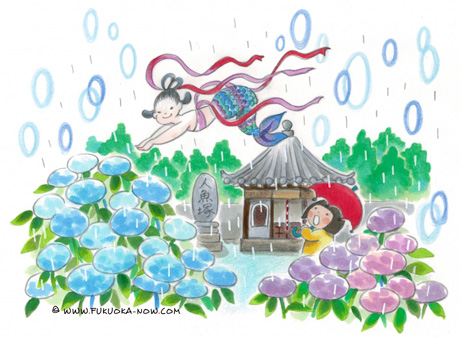Hakata Culture vol.124
Fukuoka’s Hydrangeas

Did you know that the hydrangeas that bloom during the rainy season in June and July are native to Japan? People have enjoyed these flowers since olden times, and they are even mentioned in the Collection of Ten Thousand Leaves, a poetry anthology that dates back to around the year 750. Hydrangeas are typified by large, colorful sepals (the leafy enclosure that protects the buds before they bloom) that change color, from white to blue or purple, over time. Many hybrids have been cultivated, and hydrangeas are now commonplace in Europe and North America, as well as Japan and other parts of Asia.
One of the best hydrangea viewing spots in Fukuoka is the hydrangea garden at Hakozaki Shrine. Located behind the main hall in the back west corner of the shrine grounds, the hydrangea garden provides the shrine with a colorful backdrop every June. The spacious garden measures 5,600 m2 and features 3,500 flowers of roughly 100 varieties. Meanwhile, the nearby Shin'en Flower Garden is home to 5,000 lilies, making for another beautiful stopover when you visit the shrine.
The Fukuoka Castle ruins are a well-known spot for viewing cherry blossoms, but the surrounding Maizuru Park is actually a great flower spot year-round, and there are patches of hydrangeas here and there that you can enjoy during the rainy season. It is a beautiful sight to see the colorful hydrangeas against the backdrop of the old stone walls, and the most eye-catching patch stands in front of the Shimonohashi Gomon Gate located next to the moat. Gorgeous deep yellow water lilies also come into bloom along the moat at the same time of year, so be sure to stop by and watch the two different flowers put on a sensational seasonal show of color.
Another good spot for hydrangeas is Ryuguji Temple in Hakata Ward. This cozy little temple is a great spot for a leisurely stroll, especially when the flowers are in bloom. The name of the temple is derived from ryugu-jo, the legendary underwater castle where the dragon god of the sea lived, because the bones of a “mermaid” supposedly captured in Hakata Bay in 1222 are kept in the main hall. The temple is also home to a prized Edo era scroll depicting mermaids.
福岡の街中で楽しむアジサイ
6~7月の梅雨時に開花するアジサイは日本が原産国。日本最古の和歌集「万葉集」にも登場するほど、古くから人々に愛されてきました。花のように見えるのは、一般の植物でいうところのガクが発達したもので、白から青や紫などへ時間とともに色を変えていきます。現在では品種改良されて、日本はもちろん、ヨーロッパやアメリカなどでも観賞用に栽培されています。
アジサイが福岡の街中で気軽に観賞できるスポットのひとつが筥崎宮の「あじさい苑」。境内の西奥、本殿の裏手にあり、6月になると社殿を背景に色とりどりのアジサイが咲き誇ります。およそ1700坪の敷地に約100品種、3500株のアジサイが競うように咲く様子は圧巻。近くの「神苑花庭園」では5000本のユリが見頃となるので、こちらもアジサイとあわせて楽しんでください。
桜の名所として名高い福岡城ですが、一帯を整備した舞鶴公園には四季折々にさまざまな花が咲き、アジサイも園内のあちこちに植えられています。苔むした石垣とアジサイのコントラストは風情がありますが、とりわけ美しいのがお堀に面した下之橋御門前に咲くアジサイ。同じ時期、お堀には淡い黄色をしたスイレンが開花します。アジサイとスイレンの花の競演も見事です。
博多区にある龍宮寺もまた美しいアジサイで知られるお寺。こじんまりとして静かな境内は、ゆったり散策するには最適です。ここには人魚の伝説があり、貞応元年(1222年)に博多津(現在の博多港)で捕らえられた人魚を葬ったことから現在の名前になったと伝わります。実際に人魚の骨が本堂に納められているほか、人魚の姿を描いた江戸時代の秘蔵の掛け軸もあるそうです。

